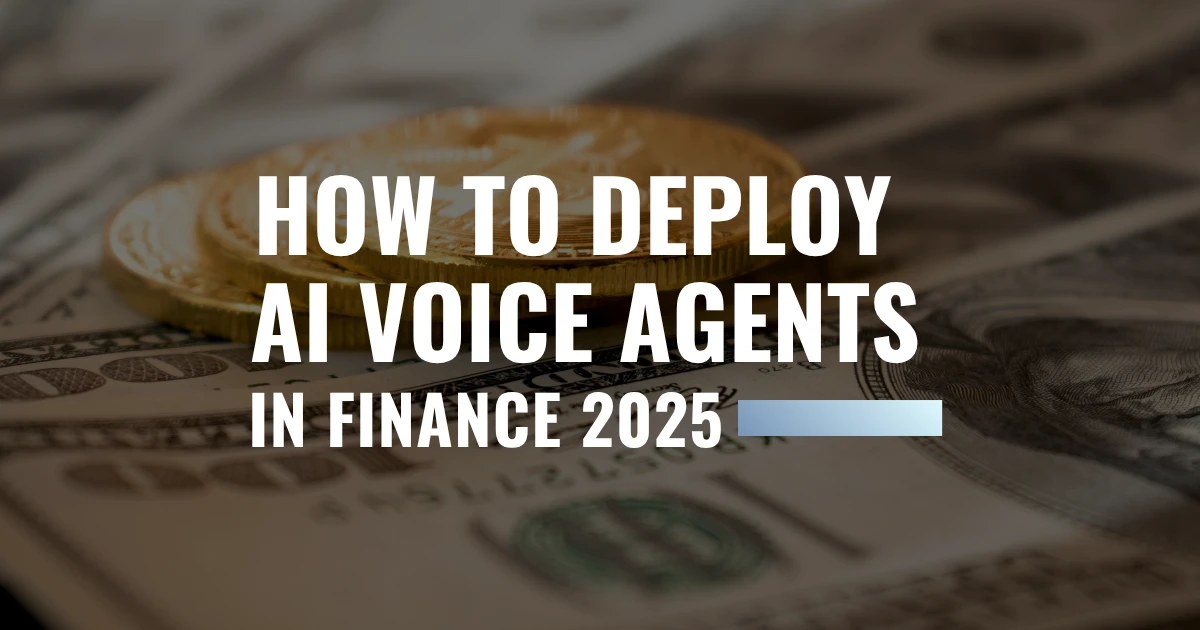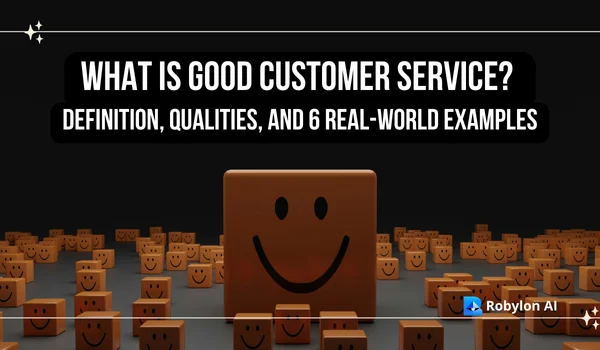TL;DR
AI voice agents are transforming how financial institutions manage customer conversations. Unlike basic IVR systems, voice AI agents for finance combine speech recognition, natural language understanding, and text-to-speech to deliver human-like assistance 24 × 7. They can automate identity checks, balance inquiries, loan follow-ups, and compliance disclosures within seconds.
A well-planned AI voice agent implementation helps banks and fintechs cut contact-center costs by up to 40 %, improve response accuracy, and ensure regulatory compliance across every call. By integrating with existing CRMs and telephony systems, these agents handle large-volume queries while enabling call center automation that scales without adding headcount.
This guide explains the business case, key use cases, and a 7-step deployment roadmap with ROI metrics so financial teams can launch voice AI responsibly and at scale.
Introduction: Voice AI Moves from Experiment to Essential
In 2025, voice AI has shifted from a futuristic idea to a financial necessity. As customers demand instant, accurate, and personalized service, traditional IVR systems can’t keep up. Banks and fintechs now face a simple choice: either automate intelligently or lose customers to those that do.
AI voice agents represent this next leap. Whether it’s confirming a payment, sending loan updates, or blocking fraudulent transactions, these systems act as tireless digital representatives that work round-the-clock, speak multiple languages, and follow regulations to the letter.
This blog breaks down everything you need to implement them, from ROI metrics and compliance frameworks to integration, scaling, and governance, and shows how platforms like Robylon AI are helping institutions make the shift seamlessly.
Voice Agents in Financial Services: A How-To Guide
1. Value drivers
- 24/7 coverage: No wait times during peaks, holidays, or outages
- Lower AHT: Real-time lookups/policy checks reduce holds
- Higher FCR: Guided flows + knowledge grounding resolve first contact
- Lower OPEX: AI call automation scales; pay per minute/call vs per agent
- Multilingual at scale: Consistent quality across languages/dialects
- Operational consistency: Scripts, disclosures, and workflows run uniformly
2. Measuring ROI
Track ROI metrics for voice AI with clear formulas and targets
- Containment rate = Automated resolutions ÷ total calls; target 60–90% (mature)
- Conversion rate (cards/loans) = Approved/progressed apps ÷ eligible intent calls (by product)
- CSAT = Satisfied surveys ÷ total; compare human vs AI cohorts
- Deflection = Calls shifted from agents to self-serve (IVR→AI or phone→SMS link)
- Cost per call = Total voice AI spend ÷ calls handled; benchmark vs human
- AHT & FCR = Standard metrics; report by intent/language/queue
- Collections uplift = AI-collected amount ÷ total due (targeted segments)
3. Compliance & brand trust
- Scripted disclosures: Verbatim fees/rates/risk by product/region
- Consent capture: Record time-stamped consent; store opt-outs
- Audit trails: Immutable transcripts/prompts/decisions/API actions
- Data controls: PII redaction, encryption in transit/at rest, least-privilege access
- Brand safety: Guardrails for tone/language; escalate risky intents to humans
Ready to quantify impact? Book a demo to see live dashboards and benchmark your cost/call today.
2025 Step-by-Step Voice AI Implementation Roadmap
1. Discovery & Prioritization
Pick 2–3 high-impact use cases in banking / financial services. Examples: AI voice agents for debt collection, onboarding reminders, KYC nudges, card activation, balance and limit checks, and loan payoff quotes. Score each by volume, repeatability, data availability, and risk. Confirm current AHT, FCR, and cost per call to baseline ROI.
2. Compliance & Risk Alignment
Create a regulatory compliance/data privacy checklist: Align to Payment Card Industry Data Security Standard (PCI DSS), Service Organization Control 2 (SOC 2), General Data Protection Regulation (GDPR), Gramm–Leach–Bliley Act (GLBA), and local rules (e.g., RBI).
Define recording consent flows and disclosures. Set PII handling rules for masking, encryption, retention, and role-based access. Document escalation for risky intents and disputes.
3. Architecture & Tooling
Plan integrations with CRM, core banking, ticketing, and telephony / SIP trunk. Select your conversational AI stack, speech recognition/text-to-speech engines, and analytics. Define latency budgets and regional routing, prepare sandbox numbers, and test accounts.
4. Design Conversation & Guardrails
Draft dialog flows for each use case. Include scripted disclosures, confirmation prompts, and fallback logic. Define agent escalation rules with warm transfer and context pass-through. Add multilingual support and tone guidelines that match your brand.
5. Data, Training & Testing
Ground the agent with a curated knowledge base. Add product terms, fees, and policy snippets. Run red-team tests for edge cases and prompt safety. Validate accents, noise, barge-in, and interruptions. Track intent accuracy, latency, and completion rate before pilot.
6. Pilot Deployment
Start small, choose one product line or geography. Set traffic split targets and a fixed timeline. Measure containment, AHT, FCR, CSAT, deflection, and cost per call. Verify call center automation interplay with staffing and queues. Review transcripts and compliance logs weekly.
7. Scale & Optimize
Expand intents and hours after hitting success thresholds. Publish ROI metrics dashboards to business, risk, and compliance. Add QA loops for script freshness and disclosure updates. Localize languages and roll out new channels.
Pro tip: Start with inbound support or focused collections flows. These deliver fast wins and clear ROI with minimal risk.
8. Operational checkpoints
- Service levels: Median latency under 600–900 ms per turn.
- Reliability: 99.9% monthly availability target for the voice pipeline.
- Quality: Intent accuracy above 90% on top intents before scale.
- Compliance: 100% disclosure delivery on regulated calls.
9. Governance and reporting
Publish a monthly report with containment, First Contact Resolution (FCR), Average Handle Time (AHT), Customer Satisfaction (CSAT), cost per call, and exceptions. Include transcript samples, redactions, and consent records. Track privacy requests and deletion proofs.
Priority Use Cases in Financial Services
1. Debt collection & reminders
- Proactive dials for due, overdue, and broken-promise segments with compliant scripts.
- Adaptive schedules that resurface at best-time-to-call windows to raise right-party contact.
- Secure payment flows that verify identity, take partials, and send instant receipts.
- Dispute capture with documented outcomes and agent escalation for sensitive cases.
- Real results: collections uplift with voice agents
2. Onboarding & KYC nudges, document checklist, and branch appointment setting
- KYC reminders for missing proofs with clear next steps and multilingual guidance.
- Checklist calls that confirm items, send upload links, and track completion in CRM.
- Branch slot booking with geo routing and calendar holds.
- Warm transfers to compliance when risk triggers fire.
3. Balance, card & loan support
- Self-serve balances, card limits, payoff quotes, and payment due dates in seconds.
- Card controls to freeze, replace, or set travel notices with audit trails.
- Loan inquiries that pre-qualify and push applications to Salesforce/HubSpot.
- Smart handoff with transcript, caller intent, and verification status.
- See faster routing and lower cost per qualified lead with voice AI.
4. Fraud alerts & confirmations with strict disclosures
- Real-time alerts on anomalous spend with scripted disclosures per product and region.
- Step-up auth using knowledge checks before sharing any account details.
- One-tap actions to confirm or deny charges, then freeze and reissue if confirmed fraud.
- Full compliance logs with time-stamped consent and redactions.
5. Payments & renewals (secure transfers via compliant flows)
- Due-date reminders that collect payments via PCI-safe paths and issue receipts.
- Auto-debit setup and renewal confirmations with terms read verbatim.
- Cross-sell eligibility checks that follow scripted language and fairness rules.
- Failed-payment recovery with retries and channel switch to SMS or email.
Get the details: ticket-resolution wins for a leading trading platform
Where does this fit in banking / financial services?
These Voice AI agents in financial services reduce queues, raise FCR, and improve collections while keeping every step auditable. Start with one or two use cases in banking / financial services that have high volume and low policy risk, then expand.
Measure, Optimize, and Scale
1. Key KPIs
Track KPIs weekly, by intent and language
- Containment rate = Automated ÷ total; 60–90% on Tier-1
- AHT = Total handle ÷ handled; double-digit reduction vs human
- FCR = First-touch resolved ÷ total; ≥85% on mature flows
- CSAT = Positive ÷ total; split AI vs human, alert if >3-pt gap
- Collections recovered = AI collected ÷ collectible; track kept-promise % and days-to-collect
- Cost per call = (telephony + platform + ops) ÷ calls; benchmark vs human and report savings %
2. Experimentation
Adopt a monthly test cadence
- A/B flows: Greetings, verification order, CTAs → target +FCR / −AHT / +CSAT
- Prompt tuning: Domain terms, throttle risky gens, offline replay first
- Policy/disclosures: Shorten (stay compliant), measure drop-off + CSAT
- Intent expansion: Observe → shadow → contain; promote at >70% containment and CSAT ±2 pts of human
- Failure forensics: Tag ASR, KB gap, auth, tool timeout; fix top 3 each sprint
3. Scale plan
Scale only after KPIs meet thresholds for 2–4 weeks
- Use cases: Add adjacent intents; re-baseline KPIs each time
- Channels: Extend to SMS/email callbacks and web chat with transcript continuity
- Languages: Add locales with glossary packs; validate ASR on accents/numerics
- Org rollout: Expand hours (after-hours → 24/7), then geos; publish monthly ROI memos to ops/risk/compliance
- Operations: Set SLOs (latency, uptime, disclosures); automate redaction and consent storage
- Governance: Quarterly audits (scripts/access/retention); annual retraining on policies
How Robylon Could Help Reshape Finance
As teams race to voice-first automation, Robylon for finance scales sales, service, and collections with secure, compliant execution. Here’s how Robylon is driving real impact
1. AI Agents for Financial Workflows
Robylon’s voice AI agents understand policy-bound conversations, follow regulatory rules, and deliver accurate, trusted responses
2. Seamless CRM and Telephony Integration
Robylon integrates directly with platforms like Salesforce, HubSpot, Twilio, and Exotel, connecting connecting voice, chat, and ticket systems under one roof.
3. Data-Driven Automation and Analytics
Every call generates metrics: containment rate, AHT (Average Handle Time), FCR, and CSAT (Customer Satisfaction); dashboards surface wins and gaps to optimize ROI.
4. Multilingual at a global scale
40+ languages with localized tone and region-specific wording for US, Asia-Pacific, and European markets.
5. From Pilot to Production, Fast
No-code + API-first setup launches pilots in <30 days, then scales systematically.
Conclusion
You now have a clear 7-step roadmap for implementing AI voice agents in financial services. Start with focused use cases. Align regulatory compliance early, wire telephony, SIP, and CRM. Design clear conversations with fallback logic and agent escalation. Grounded in the knowledge base, pilot with measurable ROI metrics, scale with governance and monthly QA.
Expected outcomes: 24/7 coverage, lower AHT, higher FCR, reduced cost per call, compliant disclosures, multilingual support, and reliable call center automation.
Prefer a guided walkthrough with live dashboards and transcripts? Book a demo for your team.
FAQs
What is the ROI of voice AI agents in finance?
ROI comes from call center automation and higher first-contact resolution. Track containment, average handle time (AHT), first call resolution (FCR), CSAT, deflection, cost per call, and collections recovered. Mature programs report double-digit AHT reductions and 60–90% containment on Tier-1 intents, improving service quality while lowering operating costs at scale.
How do voice AI agents comply with financial regulations?
Compliance hinges on consent capture, verbatim disclosures, PII minimization, encryption, and retention controls. Align with Payment Card Industry Data Security Standard (PCI DSS), Service Organization Control 2 (SOC 2), General Data Protection Regulation (GDPR), and, Gramm–Leach–Bliley Act (GLBA).
What are the challenges or risks in deploying AI voice agents in finance?
Key risks include Automatic Speech Recognition (ASR) accuracy on accents, latency during peaks, policy drift, and data privacy failures. Mitigate with glossary tuning, regional routing, scripted disclosures, controlled tool access, and redaction. Establish fallback logic and human handoffs for edge cases to protect CX and compliance while improving reliability over time.
What are the use cases of voice AI in financial services?
Common use cases in banking / financial services include debt-collection reminders, KYC nudges, card controls, balance and payoff quotes, fraud confirmations, and renewals. Agents also schedule branch appointments, verify identity, and deliver disclosures verbatim. Each workflow benefits from fast resolution, consistent policy adherence, and complete audit trails.
What are the steps to deploy a voice AI agent in 2025?
Use a seven-step path: discovery, compliance alignment, architecture selection, conversation design, data/training, pilot, and scale. Include latency targets, multilingual support, and robust monitoring. Tie each step to ROI metrics for voice AI to validate performance before expanding across products or regions.
How do you implement voice AI agents in banking/finance?
Start with high-volume intents, map compliance needs, and define success metrics. Plan integrations with CRM and telephony, then design conversation flows with guardrails and agent escalation. Pilot with a small segment, track KPIs, and iterate.
What is an AI voice agent, and how does it work?
AI voice agents use speech-to-text, natural language understanding (NLU), policy logic, and text-to-speech to run end-to-end calls in real time. They identify intent, fetch data from core systems, and respond in natural speech. Unlike IVR, they adapt to context, support multilingual flows, and log every step for compliance and analytics.









.webp)
.png)















